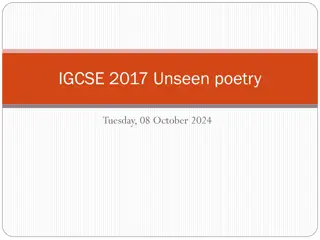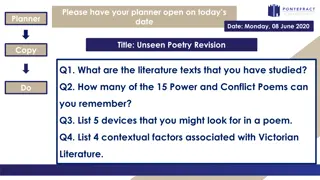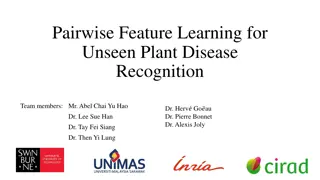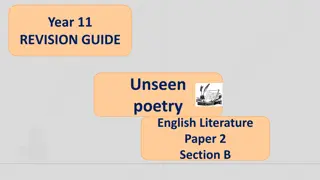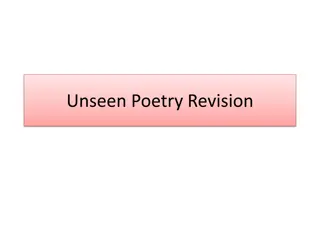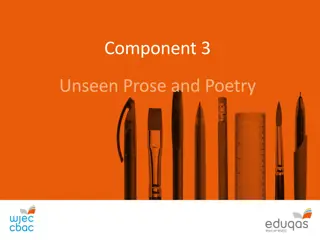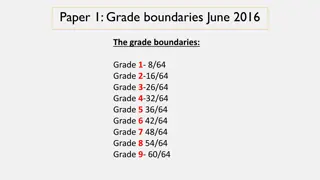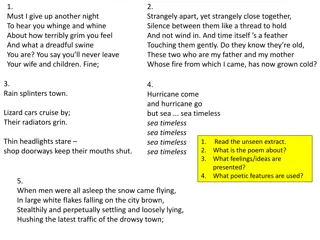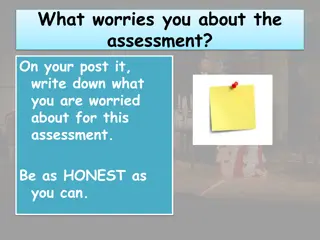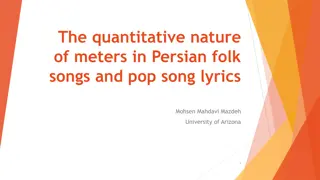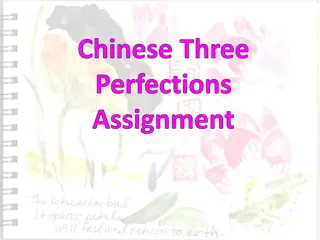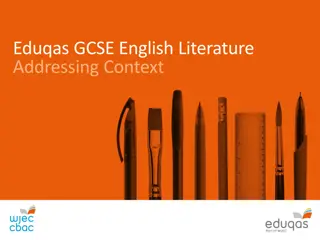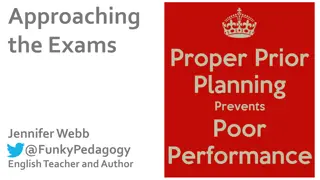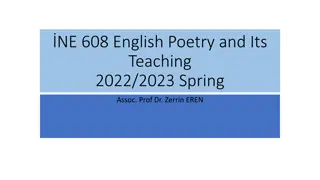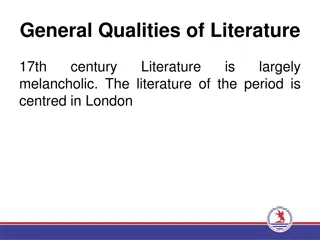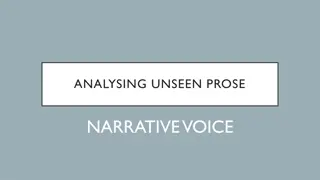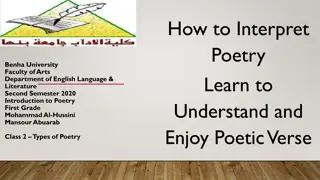Approaching Unseen Poetry in Exams: Understanding and Analysis
Exploring the process of analyzing unseen poetry in exams, focusing on understanding and making educated interpretations. Tips on comparing poems, time management, and assessment objectives are discussed in this lecture.
Download Presentation

Please find below an Image/Link to download the presentation.
The content on the website is provided AS IS for your information and personal use only. It may not be sold, licensed, or shared on other websites without obtaining consent from the author. Download presentation by click this link. If you encounter any issues during the download, it is possible that the publisher has removed the file from their server.
E N D
Presentation Transcript
AQA Unseen Poetry Lecture Approaching poems - looking for Meaning Unseen poetry is all about understanding the meaning and being able to make educated guesses about what the poet might have been trying to say and why they might have been saying this. This lecture will explore the hidden thinking process behind approaching a poem that you have never read before and explore how to compare two poems at a high level without worrying too much about getting it wrong! If you believe that unseen poetry is daunting because you are unable to learn information about the poem before you go into the exam , but want to know how expert analysis can be explored in these unknown texts, then this lecture is for you.
Unseen Poetry Lecture What do you have to do in the exam? Section A of Exam = Animal Farm (45 minutes) Question & essay response. You must include context. You are marked for SPAG 4 marks. 34 marks. Section B of Exam = Anthology (45 minutes) Comparison essay with one poem named and provided and the comparison is your choice with no copy of the poem in front of you. You must include context. Section C of Exam Unseen Poetry = Single Poem essay (30 minutes) and comparison essay (15 minutes) Part 2 is worth doing. You will be fatigued by this point in the exam it is the last 15 minutes of a 2 hour 15 minute exam, but even writing a comparison paragraph will help you gain marks. Try to leave sufficient time overall to attempt this part of the exam
Unseen Poetry Lecture What do you have to do in the exam? You will have TWO poems to read and analyse Part 1 is worth most marks and you should spend 30 minutes on this Part 2 is worth a small amount of marks but you should spend about 15 minutes on this. Part 1 = single poem essay (24 marks) You are being assessed on AO1 and AO2 your ability to understand meaning and analyse the poem Part 2 = comparison poem essay (8 marks) AO2 your ability to compare the meaning created in both poems
Unseen Poetry Lecture What do you have to do in the exam? The Assessment Objectives You are being judged on your ability to: AO1 - Read, understand and respond to texts. Students should be able to: maintain a critical style and develop an informed personal response. use textual references, including quotations, to support and illustrate interpretations. AO2 - Analyse the language, form and structure used by a writer (methods) to create meanings and effects, using relevant subject terminology where appropriate. AO3 - Show understanding of the relationships between texts and the contexts in which they were written. AO4 - Use a range of vocabulary and sentence structures for clarity, purpose and effect, with accurate spelling and punctuation. (ANIMAL FARM ONLY)
Unseen Poetry Lecture Key Approach Step 1 The Question Read the question first before reading the poem Unpick the question For Example a single poem question: In the poem Valentine how does the poet present emotions relating to love? In the highlighted selection we have: Valentine: the poem name to refer back to throughout the essay the poet: a reminder that the poet constructed the poem (look at poem for poet s surname to use, rather than poet) Emotions and love: the key focus in the question this is what you will look for quotes about when annotating/highlighting the poem
Unseen Poetry Lecture Key Approach Step 2 The First Impressions and Reading Read the poem x 2 for meaning keep in mind the key words you have identified in the question
Unseen Poetry Lecture Key Approach Step 3 The annotations and quotation selection Annotate the poem (label/highlight details relevant to the question) Do this quickly Use your instinct first Remember, only highlight/underline quotations that link to the key words from the question underline/highlight key quotations in particular: the title, line 1, the volta/change, the final line and anything that stands out to you based on the key words you identified in the question Quotations should: be relevant to the question, be a word or a phrase, be short and snappy, can be a phrase first and then zoom into a key word for the connotations of the particular word Annotations can: include you writing all over the poem your initial thoughts and ideas about the poem
Unseen Poetry Key Approach Step 4 Questions to ask yourself An internalisation process In your thinking process as you read the poem keep in mind: Explore line one next: What person is it written in and what does this suggest? What tone can you identify and why has it been used? Have you identified what method (terminology used) is in the quotation? What is the meaning of the quotation? Why do you think this? Is there a key word that helps you understand this? Can you explore the connotations of the key word? What effect does the quotation you have selected have and why? What was the poet s intention? What How Why What does the poem mean? Why do I think it means this? What clues has the poet given to the meaning? Explore the title first: What does it suggest? How does it link to the question? What are the connotations of it and why? Repeat the above process for: A turning point (volta in the poem) Any lines/phrases or words that stand out to you The final line.
Unseen Poetry Lecture Key Approach Step 5 Writing about the poem: Introduction Your annotations can help form a brief plan Create an introduction: 2 sentences maximum Sentence one summarise the meaning of the poem and how the question is relevant. Sentence two a sentence that drives your essay forward using three adjectives or three separate points about ways the key focus from the question is shown in the poem
Unseen Poetry Lecture Key Approach Step 5 Writing about the poem: Main Body of the essay Create the first paragraph of your essay Use the first adjective or the first point from the introduction in the first (topic) sentence of your essay to shape what you are going to say about the poem in the first paragraph Start with the title or quotation(s) relevant to the idea for your paragraph Include: how the question is being answered (overview of meaning), multi-quotes including phrases and key words, terminology (methods including connotations), analysis (meaning and effect), what feeling/emotions are evoked in the poem, writer s intentions, use triplets for meaning, offer valid alternative interpretations. As you are writing continue to think: What How Why Repeat the paragraph process twice more using the key adjectives or the second and third point in your introduction to shape your paragraphs avoid repeating the use of quotations throughout the essay
Unseen Poetry Lecture Key Approach Step 5 Writing about the poem: Conclusion Create a conclusion: 2 sentences maximum Answer the question by offering a judgement on how far the poet has presented the key theme or idea in their poem Sentence one link back to what you said in the introduction and judge how the ideas in the main body of the essay support the key idea in the question. Sentence two State your opinion using a *tentative* style about what the poet s intention was in writing the poem and how far they have achieved this.
Unseen Poetry Lecture Academic Essay Language Adverbs position your opinion using adverbs. For Example: Duffy judiciously presents love as multi-faceted. Duffy deliberately explores pain and suffering as well as joy and pleasure to show (See next page for Adverb Bank) Evaluative phrases support your ideas to show what the poet is telling you: suggests/implies/indicates/creates/emphasises/demonstrates/reflects (See next page for evaluative phrase bank) Tentative style use modality in the language you use to explore the poem as it shows you are aware of the element of possibility in your analysis and that there could be another interpretation: could/maybe/perhaps/might/should/possibly
Unseen Poetry Lecture Academic Essay Language Useful Evaluative Phrases Purposely Purposefully Patronisingly Rapidly Furiously Brilliantly Brutally Silently Gently Meaningfully Sympathetically Weakly Malevolently Catastrophically Adverb Bank Hesitantly Vigorously Immensely Strongly Publically Calmly Enthusiastically Perfectly Angrily Judgementally Confidently Proudly Intentionally Criticises - rebukes, admonishes, chastises, lambasts, castigates, demonises, condemns Questions queries, disputes, casts doubt upon, refutes, interrogates, examines, challenges, exposes, provokes Ridicules mocks, trivialises, satirises, lampoons, derides, pillories, parodies, caricatures Celebrates commemorates, honours, salutes, recognises, acknowledges, memorialises, lionises, fetishises, idealises, eulogises, elevates, glorifies, sentimentalises, romanticises, beautifies, deifies Subverts undermines, overturns, alters, modifies, corrupts Accepts welcomes, embraces, affirms, reaffirms, internalises, externalises
Unseen Poetry Lecture Live Model In your pack you have an unseen poem and question. This is new to me as well (I m going blind on this one). Turn to the poem now. We will go through the Unseen Process for the 24 mark question now. I will explain my thought process as we do this: Unpick the question Read the poem x 2 Annotate key quotations Scribble/write notes or annotations Write an introduction using 3 key adjectives or ideas for the poem Write one paragraph using the introduction idea one as a topic sentence Write an indicative conclusion as if we have analysed the whole poem
Unseen Poetry Key Approach Step 1 Comparison Question Read the question before reading the second poem: In both Valentine and Sonnet 43 the speakers describe emotions that relate to love. What are the similarities and/or differences between the ways the poets present these emotions? In the highlighted selection we have: Both: a reminder that this is a comparison essay about TWO poems crucially you can repeat analysis from the single poem essay Valentine and Sonnet 43: the poem names to refer back to throughout the essay the speaker: a reminder that the speaker is the persona in the poem and that the poet constructed the poem (look at poems for poet s surname to use, rather than poet) Emotions and love: the key focus in the question this is what you will look for quotes about when annotating/highlighting the poem Similarities and/or differences: a reminder that you can compare how they link and are similar or contrast how they are different and don t link thoughts Emotions: a reminder of the key focus in the comparison you make [8 marks]
Unseen Poetry Lecture Key Approach Step 2 The comparative points when reading Read the 2ndpoem x 2 for meaning keep in mind the key words you have identified in the question and whether it is similar or different to poem 1
Unseen Poetry Lecture Key Approach Step 3 The annotations and quotation selection to compare Annotate the poem (label/highlight details relevant to the question) While doing this label (s) for similarity and (d) for difference Look at comparing: the title, first line, change/volta and final line This will be a quick process as you have already thoroughly analysed poem 1
Unseen Poetry Key Approach Step 4 Questions & connectives the comparison process In your thinking process as you read the poem keep in mind: Keep in mind the following compare and contrast connectives and phrases: Contrasting (differences) However On the other hand On the contrary Instead As for Alternatively Despite this whereas while... although yet What How Why Similarity - Differences Comparing (similarities) Compared with Similarly In the same way Likewise Equally As with are similar in that What does the poem mean? How/why is it similar or different to the first poem? What quotations shall I compare? Why are they comparable?
Unseen Poetry Lecture Key Approach Step 5 Writing the comparison poem essay Go straight into the comparison and write a continuous essay comparing the two poems. Use the phrase to start: Both poems present/introduce/discuss Then link to the question and explain how they present the ideas similarly or differently (this is an overview statement about both poems) write about poem 2 (analyse quotation(s) as normal) use a connective to link it to poem 1 (analyse quotation(s) as normal) repeat the comparison process as many times as you can Complete a conclusive overview statement or judgement on how both poems are similar or different.
Unseen Poetry Lecture Live Model - Comparing In your pack you have the partner unseen poem and comparison question. Again, this is new to me as well (I m going blind on this one). Turn to the poem now. We will go through the Unseen Process for the 8 mark question now. I will explain my thought process as we do this: Unpick the question Read the poem x 2 thinking about similarities and differences Annotate key comparative ideas (s) or (d) Scribble/write notes or annotations Start the writing process compare both poems.
Unseen Poetry Lecture Top Tips Stick to timings: 30 minutes single poem; 15 minutes comparison Guide your single poem essay with the introduction Conclude with a judgement In the comparison just write how they present ideas similarly or differently Use academic language to explore and analyse the poems in both the single and the comparison essay Don t get hung up on overly deep metaphorical meanings for the single or the comparison Use terminology when you know it (connotations and imagery are your friends here) Don t panic Use the clue to meaning given to you in the question it is a gift from the examiner (they are telling you what the poem is about and giving you a clue on what to look for) If in doubt write it down use your instincts they are usually fairly accurate


